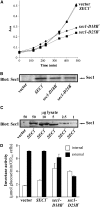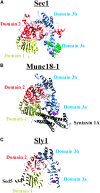A random mutagenesis approach to isolate dominant-negative yeast sec1 mutants reveals a functional role for domain 3a in yeast and mammalian Sec1/Munc18 proteins
- PMID: 18757920
- PMCID: PMC2535671
- DOI: 10.1534/genetics.108.090423
A random mutagenesis approach to isolate dominant-negative yeast sec1 mutants reveals a functional role for domain 3a in yeast and mammalian Sec1/Munc18 proteins
Abstract
SNAP receptor (SNARE) and Sec1/Munc18 (SM) proteins are required for all intracellular membrane fusion events. SNAREs are widely believed to drive the fusion process, but the function of SM proteins remains unclear. To shed light on this, we screened for dominant-negative mutants of yeast Sec1 by random mutagenesis of a GAL1-regulated SEC1 plasmid. Mutants were identified on the basis of galactose-inducible growth arrest and inhibition of invertase secretion. This effect of dominant-negative sec1 was suppressed by overexpression of the vesicle (v)-SNAREs, Snc1 and Snc2, but not the target (t)-SNAREs, Sec9 and Sso2. The mutations isolated in Sec1 clustered in a hotspot within domain 3a, with F361 mutated in four different mutants. To test if this region was generally involved in SM protein function, the F361-equivalent residue in mammalian Munc18-1 (Y337) was mutated. Overexpression of the Munc18-1 Y337L mutant in bovine chromaffin cells inhibited the release kinetics of individual exocytosis events. The Y337L mutation impaired binding of Munc18-1 to the neuronal SNARE complex, but did not affect its binary interaction with syntaxin1a. Taken together, these data suggest that domain 3a of SM proteins has a functionally important role in membrane fusion. Furthermore, this approach of screening for dominant-negative mutants in yeast may be useful for other conserved proteins, to identify functionally important domains in their mammalian homologs.
Figures






Similar articles
-
The Sec1/Munc18 Protein Groove Plays a Conserved Role in Interaction with Sec9p/SNAP-25.Traffic. 2016 Feb;17(2):131-53. doi: 10.1111/tra.12349. Epub 2015 Dec 21. Traffic. 2016. PMID: 26572066
-
Comparative studies of Munc18c and Munc18-1 reveal conserved and divergent mechanisms of Sec1/Munc18 proteins.Proc Natl Acad Sci U S A. 2013 Aug 27;110(35):E3271-80. doi: 10.1073/pnas.1311232110. Epub 2013 Aug 5. Proc Natl Acad Sci U S A. 2013. PMID: 23918365 Free PMC article.
-
Syntaxin/Munc18 interactions in the late events during vesicle fusion and release in exocytosis.J Biol Chem. 2004 Jul 30;279(31):32751-60. doi: 10.1074/jbc.M400827200. Epub 2004 Jun 1. J Biol Chem. 2004. PMID: 15175344
-
The membrane fusion enigma: SNAREs, Sec1/Munc18 proteins, and their accomplices--guilty as charged?Annu Rev Cell Dev Biol. 2012;28:279-308. doi: 10.1146/annurev-cellbio-101011-155818. Annu Rev Cell Dev Biol. 2012. PMID: 23057743 Review.
-
Decoding the interactions of SM proteins with SNAREs.ScientificWorldJournal. 2005 Jun 8;5:471-7. doi: 10.1100/tsw.2005.53. ScientificWorldJournal. 2005. PMID: 15962202 Free PMC article. Review.
Cited by
-
In Silico identification of angiotensin-converting enzyme inhibitory peptides from MRJP1.PLoS One. 2020 Feb 3;15(2):e0228265. doi: 10.1371/journal.pone.0228265. eCollection 2020. PLoS One. 2020. PMID: 32012183 Free PMC article.
-
Possible roles for Munc18-1 domain 3a and Syntaxin1 N-peptide and C-terminal anchor in SNARE complex formation.Proc Natl Acad Sci U S A. 2011 Jan 18;108(3):1040-5. doi: 10.1073/pnas.0914906108. Epub 2010 Dec 30. Proc Natl Acad Sci U S A. 2011. PMID: 21193638 Free PMC article.
-
Identification of residues critical for the extension of Munc18-1 domain 3a.BMC Biol. 2023 Jul 13;21(1):158. doi: 10.1186/s12915-023-01655-6. BMC Biol. 2023. PMID: 37443000 Free PMC article.
-
The SM protein Vps33 and the t-SNARE H(abc) domain promote fusion pore opening.Nat Struct Mol Biol. 2010 Jun;17(6):710-7. doi: 10.1038/nsmb.1809. Epub 2010 May 9. Nat Struct Mol Biol. 2010. PMID: 20453860
-
Evidence for an interaction between Golli and STIM1 in store-operated calcium entry.Biochem J. 2010 Sep 15;430(3):453-60. doi: 10.1042/BJ20100650. Biochem J. 2010. PMID: 20629634 Free PMC article.
References
-
- Barclay, J. W., T. J. Craig, R. J. Fisher, L. F. Ciufo, G. J. O. Evans et al., 2003. Phosphorylation of Munc18 by protein kinase C regulates the kinetics of exocytosis. J. Biol. Chem. 278 10538–10545. - PubMed
-
- Brummer, M. H., K. J. Kivinen, J. Jantti, J. Toikkanen, H. Soderlund et al., 2001. Characterization of the sec1-1 and sec1-11 mutations. Yeast 18 1525–1536. - PubMed
Publication types
MeSH terms
Substances
Grants and funding
LinkOut - more resources
Full Text Sources
Molecular Biology Databases
Research Materials

